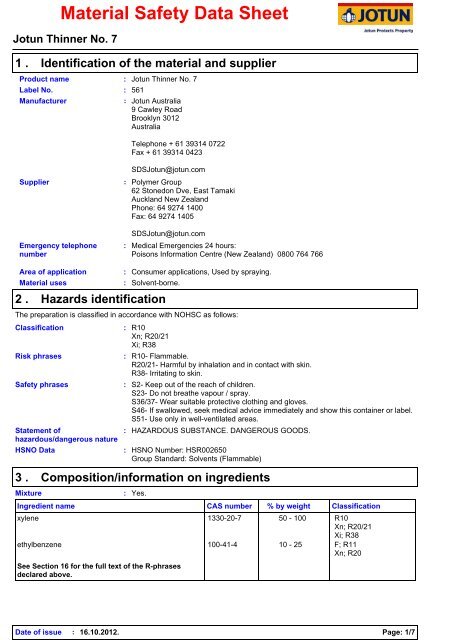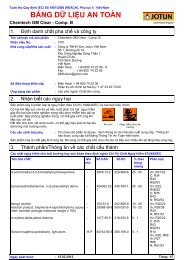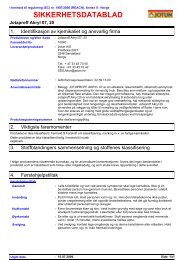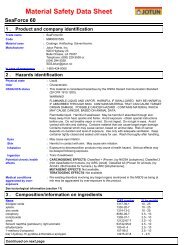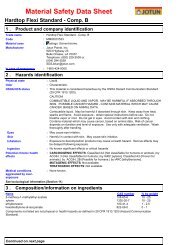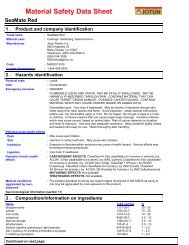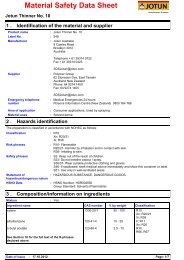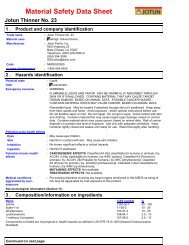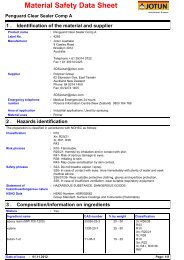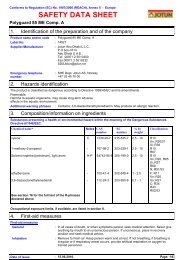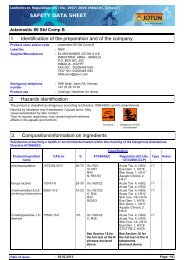Jotun Thinner No. 7 - Marine_Protective - English (uk) - New
Jotun Thinner No. 7 - Marine_Protective - English (uk) - New
Jotun Thinner No. 7 - Marine_Protective - English (uk) - New
You also want an ePaper? Increase the reach of your titles
YUMPU automatically turns print PDFs into web optimized ePapers that Google loves.
Material Safety Data Sheet<br />
<strong>Jotun</strong> <strong>Thinner</strong> <strong>No</strong>. 7<br />
1 .<br />
Identification of the material and supplier<br />
Product name<br />
: <strong>Jotun</strong> <strong>Thinner</strong> <strong>No</strong>. 7<br />
Label <strong>No</strong>. : 561<br />
Manufacturer<br />
: <strong>Jotun</strong> Australia<br />
9 Cawley Road<br />
Brooklyn 3012<br />
Australia<br />
Telephone + 61 39314 0722<br />
Fax + 61 39314 0423<br />
SDS<strong>Jotun</strong>@jotun.com<br />
Supplier<br />
: Polymer Group<br />
62 Stonedon Dve, East Tamaki<br />
Auckland <strong>New</strong> Zealand<br />
Phone: 64 9274 1400<br />
Fax: 64 9274 1405<br />
Emergency telephone<br />
number<br />
:<br />
SDS<strong>Jotun</strong>@jotun.com<br />
Medical Emergencies 24 hours:<br />
Poisons Information Centre (<strong>New</strong> Zealand) 0800 764 766<br />
Area of application : Consumer applications, Used by spraying.<br />
Material uses<br />
: Solvent-borne.<br />
2 . Hazards identification<br />
The preparation is classified in accordance with NOHSC as follows:<br />
Classification<br />
Risk phrases<br />
Safety phrases<br />
Statement of<br />
hazardous/dangerous nature<br />
HSNO Data<br />
:<br />
:<br />
:<br />
R10<br />
Xn; R20/21<br />
Xi; R38<br />
R10- Flammable.<br />
R20/21- Harmful by inhalation and in contact with skin.<br />
R38- Irritating to skin.<br />
S2- Keep out of the reach of children.<br />
S23- Do not breathe vapour / spray.<br />
S36/37- Wear suitable protective clothing and gloves.<br />
S46- If swallowed, seek medical advice immediately and show this container or label.<br />
S51- Use only in well-ventilated areas.<br />
: HAZARDOUS SUBSTANCE. DANGEROUS GOODS.<br />
: HSNO Number: HSR002650<br />
Group Standard: Solvents (Flammable)<br />
3 .<br />
Composition/information on ingredients<br />
Mixture<br />
: Yes.<br />
Ingredient name CAS number % by weight Classification<br />
xylene 1330-20-7 50 - 100 R10<br />
Xn; R20/21<br />
Xi; R38<br />
ethylbenzene 100-41-4 10 - 25 F; R11<br />
Xn; R20<br />
See Section 16 for the full text of the R-phrases<br />
declared above.<br />
Date of issue : 16.10.2012.<br />
Page: 1/7
<strong>Jotun</strong> <strong>Thinner</strong> <strong>No</strong>. 7<br />
4 .<br />
First-aid measures<br />
First-aid measures<br />
Eye contact<br />
Skin contact<br />
Inhalation<br />
Ingestion<br />
Protection of first-aiders<br />
:<br />
:<br />
:<br />
:<br />
Immediately flush eyes with plenty of water, occasionally lifting the upper and lower<br />
eyelids. Check for and remove any contact lenses. Continue to rinse for at least 10<br />
minutes. Get medical attention.<br />
Flush contaminated skin with plenty of water. Remove contaminated clothing and<br />
shoes. Wash contaminated clothing thoroughly with water before removing it, or wear<br />
gloves. Continue to rinse for at least 10 minutes. Get medical attention. Wash<br />
clothing before reuse. Clean shoes thoroughly before reuse.<br />
Remove victim to fresh air and keep at rest in a position comfortable for breathing. If<br />
it is suspected that fumes are still present, the rescuer should wear an appropriate<br />
mask or self-contained breathing apparatus. If not breathing, if breathing is irregular<br />
or if respiratory arrest occurs, provide artificial respiration or oxygen by trained<br />
personnel. It may be dangerous to the person providing aid to give mouth-to-mouth<br />
resuscitation. Get medical attention. If unconscious, place in recovery position and<br />
get medical attention immediately. Maintain an open airway. Loosen tight clothing<br />
such as a collar, tie, belt or waistband.<br />
Wash out mouth with water. Remove dentures if any. Remove victim to fresh air and<br />
keep at rest in a position comfortable for breathing. If material has been swallowed<br />
and the exposed person is conscious, give small quantities of water to drink. Stop if<br />
the exposed person feels sick as vomiting may be dangerous. Do not induce vomiting<br />
unless directed to do so by medical personnel. If vomiting occurs, the head should be<br />
kept low so that vomit does not enter the lungs. Get medical attention if adverse<br />
health effects persist or are severe. Never give anything by mouth to an unconscious<br />
person. If unconscious, place in recovery position and get medical attention<br />
immediately. Maintain an open airway. Loosen tight clothing such as a collar, tie, belt<br />
or waistband.<br />
: <strong>No</strong> action shall be taken involving any personal risk or without suitable training. It may<br />
be dangerous to the person providing aid to give mouth-to-mouth resuscitation.<br />
5 .<br />
Fire-fighting measures<br />
Extinguishing media<br />
Suitable :<br />
<strong>No</strong>t suitable :<br />
Special exposure hazards :<br />
Special protective<br />
equipment for fire-fighters<br />
Hazchem code<br />
:<br />
Use dry chemical, CO2, water spray (fog) or foam.<br />
Do not use water jet.<br />
Promptly isolate the scene by removing all persons from the vicinity of the incident if<br />
there is a fire. <strong>No</strong> action shall be taken involving any personal risk or without suitable<br />
training. Move containers from fire area if this can be done without risk. Use water<br />
spray to keep fire-exposed containers cool.<br />
Flammable liquid. In a fire or if heated, a pressure increase will occur and the<br />
container may burst, with the risk of a subsequent explosion. Runoff to sewer may<br />
create fire or explosion hazard.<br />
Fire-fighters should wear appropriate protective equipment and self-contained<br />
breathing apparatus (SCBA) with a full face-piece operated in positive pressure<br />
mode.<br />
: 3[Y]<br />
6 .<br />
Accidental release measures<br />
Personal precautions<br />
Environmental precautions<br />
:<br />
:<br />
<strong>No</strong> action shall be taken involving any personal risk or without suitable training.<br />
Evacuate surrounding areas. Keep unnecessary and unprotected personnel from<br />
entering. Do not touch or walk through spilt material. Shut off all ignition sources. <strong>No</strong><br />
flares, smoking or flames in hazard area. Avoid breathing vapour or mist. Provide<br />
adequate ventilation. Wear appropriate respirator when ventilation is inadequate. Put<br />
on appropriate personal protective equipment (see Section 8).<br />
Avoid dispersal of spilt material and runoff and contact with soil, waterways, drains<br />
and sewers. Inform the relevant authorities if the product has caused environmental<br />
pollution (sewers, waterways, soil or air).<br />
Date of issue : 16.10.2012.<br />
Page: 2/7
<strong>Jotun</strong> <strong>Thinner</strong> <strong>No</strong>. 7<br />
Methods for cleaning up<br />
7 .<br />
Handling and storage<br />
: Stop leak if without risk. Move containers from spill area. Approach the release from<br />
upwind. Prevent entry into sewers, water courses, basements or confined areas.<br />
Wash spillages into an effluent treatment plant or proceed as follows. Contain and<br />
collect spillage with non-combustible, absorbent material e.g. sand, earth, vermiculite<br />
or diatomaceous earth and place in container for disposal according to local<br />
regulations (see section 13). Use spark-proof tools and explosion-proof equipment.<br />
Dispose of via a licensed waste disposal contractor. Contaminated absorbent<br />
material may pose the same hazard as the spilt product. <strong>No</strong>te: see section 1 for<br />
emergency contact information and section 13 for waste disposal.<br />
Contain and collect spillage with an electrically protected vacuum cleaner or by wetbrushing<br />
and place in container for disposal according to local regulations (see<br />
section 13).<br />
Handling<br />
Storage<br />
:<br />
:<br />
Put on appropriate personal protective equipment (see Section 8). Eating, drinking<br />
and smoking should be prohibited in areas where this material is handled, stored and<br />
processed. Workers should wash hands and face before eating, drinking and<br />
smoking. Remove contaminated clothing and protective equipment before entering<br />
eating areas. Do not ingest. Avoid contact with eyes, skin and clothing. Avoid<br />
breathing vapour or mist. Use only with adequate ventilation. Wear appropriate<br />
respirator when ventilation is inadequate. Do not enter storage areas and confined<br />
spaces unless adequately ventilated. Keep in the original container or an approved<br />
alternative made from a compatible material, kept tightly closed when not in use.<br />
Store and use away from heat, sparks, open flame or any other ignition source. Use<br />
explosion-proof electrical (ventilating, lighting and material handling) equipment. Use<br />
non-sparking tools. Take precautionary measures against electrostatic discharges.<br />
To avoid fire or explosion, dissipate static electricity during transfer by earthing and<br />
bonding containers and equipment before transferring material. Empty containers<br />
retain product residue and can be hazardous. Do not reuse container.<br />
The handle provided on the package is for manual handling only. Transport and<br />
transfer should be carried out with appropriate equipment and carriage devices.<br />
Store in accordance with local regulations. Store in a segregated and approved area.<br />
Store in original container protected from direct sunlight in a dry, cool and wellventilated<br />
area, away from incompatible materials (see section 10) and food and<br />
drink. Eliminate all ignition sources. Separate from oxidizing materials. Keep<br />
container tightly closed and sealed until ready for use. Containers that have been<br />
opened must be carefully resealed and kept upright to prevent leakage. Do not store<br />
in unlabelled containers. Use appropriate containment to avoid environmental<br />
contamination.<br />
8 .<br />
Exposure controls/personal protection<br />
Ingredient name<br />
Exposure limits<br />
xylene Safe Work Australia (Australia, 8/2005).<br />
STEL: 655 mg/m³ 15 minute(s).<br />
STEL: 150 ppm 15 minute(s).<br />
TWA: 350 mg/m³ 8 hour(s).<br />
TWA: 80 ppm 8 hour(s).<br />
ethylbenzene ASCC (Australia, 8/2005).<br />
STEL: 543 mg/m³ 15 minute(s).<br />
STEL: 125 ppm 15 minute(s).<br />
TWA: 434 mg/m³ 8 hour(s).<br />
TWA: 100 ppm 8 hour(s).<br />
Recommended monitoring<br />
procedures<br />
Engineering measures<br />
Hygiene measures<br />
: If this product contains ingredients with exposure limits, personal, workplace<br />
atmosphere or biological monitoring may be required to determine the effectiveness<br />
of the ventilation or other control measures and/or the necessity to use respiratory<br />
protective equipment.<br />
:<br />
:<br />
Use only with adequate ventilation. Use process enclosures, local exhaust ventilation<br />
or other engineering controls to keep worker exposure to airborne contaminants<br />
below any recommended or statutory limits. The engineering controls also need to<br />
keep gas, vapour or dust concentrations below any lower explosive limits. Use<br />
explosion-proof ventilation equipment.<br />
Wash hands, forearms and face thoroughly after handling chemical products, before<br />
eating, smoking and using the lavatory and at the end of the working period.<br />
Appropriate techniques should be used to remove potentially contaminated clothing.<br />
Wash contaminated clothing before reusing. Ensure that eyewash stations and safety<br />
showers are close to the workstation location.<br />
Date of issue : 16.10.2012.<br />
Page: 3/7
<strong>Jotun</strong> <strong>Thinner</strong> <strong>No</strong>. 7<br />
Personal protection<br />
Eyes<br />
Hands<br />
Respiratory :<br />
Skin<br />
Environmental exposure<br />
controls<br />
9 .<br />
Physical state<br />
:<br />
:<br />
:<br />
Safety eyewear complying with an approved standard should be used when a risk<br />
assessment indicates this is necessary to avoid exposure to liquid splashes, mists or<br />
dusts.<br />
Chemical-resistant, impervious gloves complying with an approved standard should<br />
be worn at all times when handling chemical products if a risk assessment indicates<br />
this is necessary.<br />
Use a properly fitted, air-purifying or air-fed respirator complying with an approved<br />
standard if a risk assessment indicates this is necessary. Respirator selection must<br />
be based on known or anticipated exposure levels, the hazards of the product and the<br />
safe working limits of the selected respirator.<br />
Personal protective equipment for the body should be selected based on the task<br />
being performed and the risks involved and should be approved by a specialist before<br />
handling this product.<br />
: Emissions from ventilation or work process equipment should be checked to ensure<br />
they comply with the requirements of environmental protection legislation. In some<br />
cases, fume scrubbers, filters or engineering modifications to the process equipment<br />
will be necessary to reduce emissions to acceptable levels.<br />
Physical and chemical properties<br />
:<br />
Liquid.<br />
Colour<br />
: Clear.<br />
Odour<br />
: Characteristic.<br />
Density : 0.87 g/cm 3<br />
Flash point<br />
: Closed cup: 27°C (80,6°F)<br />
Solubility<br />
: Insoluble in the following materials: cold water and hot water.<br />
10 .<br />
Stability and reactivity<br />
Stability :<br />
Stable under recommended storage and handling conditions (see section 7).<br />
Hazardous decomposition products: carbon monoxide, carbon dioxide, smoke, oxides<br />
of nitrogen.<br />
Keep away from the following materials to prevent strong exothermic reactions:<br />
oxidising agents, strong alkalis, strong acids.<br />
Hazardous decomposition<br />
products<br />
Materials to avoid/<br />
Hazardous Reactions<br />
: Decomposition products may include the following materials: carbon monoxide,<br />
carbon dioxide, smoke, oxides of nitrogen.<br />
:<br />
Keep away from the following materials to prevent strong exothermic reactions:<br />
oxidising agents, strong alkalis, strong acids.<br />
Conditions to avoid<br />
:<br />
Keep away from heat, sparks and flame.<br />
11 .<br />
Toxicological information<br />
There are no data available on the preparation itself. The preparation has been assessed following the conventional method<br />
of the Dangerous Preparations Directive 1999/45/EC and classified for toxicological hazards accordingly. See sections 2 and<br />
15 for details.<br />
Exposure to component solvent vapour concentrations in excess of the stated occupational exposure limit may result in<br />
adverse health effects such as mucous membrane and respiratory system irritation and adverse effects on the kidneys, liver<br />
and central nervous system. Symptoms and signs include headache, dizziness, fatigue, muscular weakness, drowsiness and,<br />
in extreme cases, loss of consciousness.<br />
Solvents may cause some of the above effects by absorption through the skin. Repeated or prolonged contact with the<br />
preparation may cause removal of natural fat from the skin, resulting in non-allergic contact dermatitis and absorption through<br />
the skin.<br />
If splashed in the eyes, the liquid may cause irritation and reversible damage.<br />
Ingestion may cause nausea, diarrhea and vomiting.<br />
This takes into account, where known, delayed and immediate effects and also chronic effects of components from shortterm<br />
and long-term exposure by oral, inhalation and dermal routes of exposure and eye contact.<br />
Potential acute health effects<br />
Date of issue : 16.10.2012.<br />
Page: 4/7
<strong>Jotun</strong> <strong>Thinner</strong> <strong>No</strong>. 7<br />
Inhalation<br />
Ingestion<br />
Skin contact<br />
Eye contact<br />
:<br />
:<br />
:<br />
:<br />
Harmful by inhalation.<br />
Irritating to mouth, throat and stomach.<br />
Harmful in contact with skin. Irritating to skin.<br />
May cause eye irritation.<br />
Acute toxicity<br />
Toxicity data<br />
: <strong>No</strong>t available.<br />
Potential chronic health effects<br />
Carcinogenicity<br />
Ingredient name ACGIH EPA OSHA IARC NIOSH NTP<br />
xylene A4 - - 3 - -<br />
ethylbenzene A3 - - 2B - -<br />
Mutagenicity<br />
Reproductive toxicity<br />
:<br />
:<br />
<strong>No</strong> known significant effects or critical hazards.<br />
<strong>No</strong> known significant effects or critical hazards.<br />
Over-exposure signs/symptoms<br />
Inhalation<br />
: <strong>No</strong> known significant effects or critical hazards.<br />
Ingestion<br />
Skin<br />
:<br />
:<br />
<strong>No</strong> known significant effects or critical hazards.<br />
<strong>No</strong> known significant effects or critical hazards.<br />
12 .<br />
Ecological information<br />
There are no data available on the preparation itself.<br />
Do not allow to enter drains or watercourses.<br />
The preparation has been assessed following the conventional method of the Dangerous Preparations Directive<br />
1999/45/EC and is not classified as dangerous for the environment.<br />
Ecotoxicity<br />
Aquatic ecotoxicity<br />
: <strong>No</strong> known significant effects or critical hazards.<br />
Product/ingredient name<br />
Result<br />
Species<br />
Exposure<br />
ethylbenzene Acute EC50 7,2 mg/L Algae 48 hours<br />
Acute EC50 2,93 mg/L Daphnia 48 hours<br />
Acute LC50 4,2 mg/L Fish 96 hours<br />
Conclusion/Summary<br />
Other ecological information<br />
Persistence/degradability<br />
Conclusion/Summary<br />
: <strong>No</strong>t available.<br />
: <strong>No</strong>t available.<br />
Product/ingredient name Aquatic half-life Photolysis Biodegradability<br />
xylene - - Readily<br />
ethylbenzene - - Readily<br />
Bioaccumulative potential<br />
Product/ingredient name LogPow BCF Potential<br />
xylene 3,12 - high<br />
Other adverse effects<br />
: <strong>No</strong> known significant effects or critical hazards.<br />
13 .<br />
Disposal considerations<br />
Methods of disposal<br />
: The generation of waste should be avoided or minimised wherever possible. Empty<br />
containers or liners may retain some product residues. This material and its container<br />
must be disposed of in a safe way. Significant quantities of waste product residues<br />
should not be disposed of via the foul sewer but processed in a suitable effluent<br />
treatment plant. Dispose of surplus and non-recyclable products via a licensed waste<br />
disposal contractor. Disposal of this product, solutions and any by-products should at<br />
all times comply with the requirements of environmental protection and waste<br />
disposal legislation and any regional local authority requirements. Avoid dispersal of<br />
spilt material and runoff and contact with soil, waterways, drains and sewers.<br />
Date of issue : 16.10.2012.<br />
Page: 5/7
<strong>Jotun</strong> <strong>Thinner</strong> <strong>No</strong>. 7<br />
14 .<br />
Transport information<br />
Transport within user’s premises: always transport in closed containers that are upright and secure. Ensure that<br />
persons transporting the product know what to do in the event of an accident or spillage.<br />
International transport regulations<br />
Proper shipping name : Xylenes<br />
UN Number : 1307<br />
Class : 3<br />
Packing group<br />
:<br />
Label :<br />
III<br />
Additional information<br />
ADG Proper shipping name<br />
ADG Label<br />
:<br />
:<br />
Xylenes<br />
ADG Hazchem code<br />
:<br />
3[Y]<br />
ADR / RID<br />
: Tunnel restriction code: (D/E)<br />
IMDG<br />
:<br />
Hazard identification number: 30<br />
Emergency schedules (EmS): F-E, S-D<br />
<strong>Marine</strong> pollutant: <strong>No</strong>.<br />
Transport in accordance with ADR/RID, IMDG/IMO and ICAO/IATA and national regulation.<br />
15 .<br />
Regulatory information<br />
National regulations<br />
Standard for the Uniform Scheduling of Drugs and Poisons<br />
5<br />
Control of Scheduled Carcinogenic Substances<br />
Ingredient name<br />
<strong>No</strong> listed substance<br />
Schedule<br />
Australia inventory (AICS)<br />
<strong>New</strong> Zealand Inventory of<br />
Chemicals (NZIoC)<br />
HSNO Data<br />
HSNO Classification<br />
EU regulations<br />
: All ingredients are listed on AICS or are exempt.<br />
: All components listed or exempt from listing on the <strong>New</strong> Zealand Inventory of<br />
Chemicals (NZIoC).<br />
: HSNO Number: HSR002650<br />
Group Standard: Solvents (Flammable)<br />
: 3.1 - FLAMMABLE LIQUIDS - Category C<br />
6.1 - ACUTE TOXICITY: ORAL - Category D<br />
6.1 - ACUTE TOXICITY: SKIN - Category E<br />
6.3 - SKIN IRRITATION - Category A<br />
6.4 - EYE IRRITATION - Category A (Irritant)<br />
6.8 - REPRODUCTIVE AND DEVELOPMENTAL TOXICITY [Fertility] - Category B<br />
6.8 - REPRODUCTIVE AND DEVELOPMENTAL TOXICITY [Unborn child] -<br />
Category B<br />
6.9 - SPECIFIC TARGET ORGAN TOXICITY (SINGLE OR REPEATED<br />
EXPOSURE): ORAL - Category B<br />
6.9 - SPECIFIC TARGET ORGAN TOXICITY (SINGLE OR REPEATED<br />
EXPOSURE): INHALATION - Category B<br />
9.3 - TERRESTRIAL VERTEBRATE ECOTOXICITY - Category C<br />
: The product is classified and labelled for supply in accordance with the Directive<br />
1999/45/EC as follows:<br />
Date of issue : 16.10.2012.<br />
Page: 6/7
<strong>Jotun</strong> <strong>Thinner</strong> <strong>No</strong>. 7<br />
Hazard symbol or<br />
symbols<br />
:<br />
Harmful<br />
Contains<br />
: xylene<br />
Risk phrases : R10- Flammable.<br />
R20/21- Harmful by inhalation and in contact with skin.<br />
R38- Irritating to skin.<br />
Safety phrases : S2- Keep out of the reach of children.<br />
S23- Do not breathe vapour / spray.<br />
S36/37- Wear suitable protective clothing and gloves.<br />
S46- If swallowed, seek medical advice immediately and show this container or label.<br />
S51- Use only in well-ventilated areas.<br />
US regulations<br />
HCS Classification<br />
16 .<br />
Disclaimer<br />
Other information<br />
Full text of R-phrases referred<br />
to in sections 2 and 3<br />
<strong>No</strong>tice to reader<br />
History<br />
: Flammable liquid<br />
Carcinogen<br />
: R11- Highly flammable.<br />
R10- Flammable.<br />
R20- Harmful by inhalation.<br />
R20/21- Harmful by inhalation and in contact with skin.<br />
R38- Irritating to skin.<br />
Date of printing<br />
: 16.10.2012.<br />
Date of issue : 16.10.2012.<br />
Version<br />
: 5<br />
Prepared by<br />
: <strong>Jotun</strong> Group Product Safety Department<br />
To the best of our knowledge, the information contained herein is accurate. However, neither the above-named supplier,<br />
nor any of its subsidiaries, assumes any liability whatsoever for the accuracy or completeness of the information<br />
contained herein.<br />
Final determination of suitability of any material is the sole responsibility of the user. All materials may present unknown<br />
hazards and should be used with caution. Although certain hazards are described herein, we cannot guarantee that<br />
these are the only hazards that exist.<br />
Date of issue : 16.10.2012.<br />
Page: 7/7


